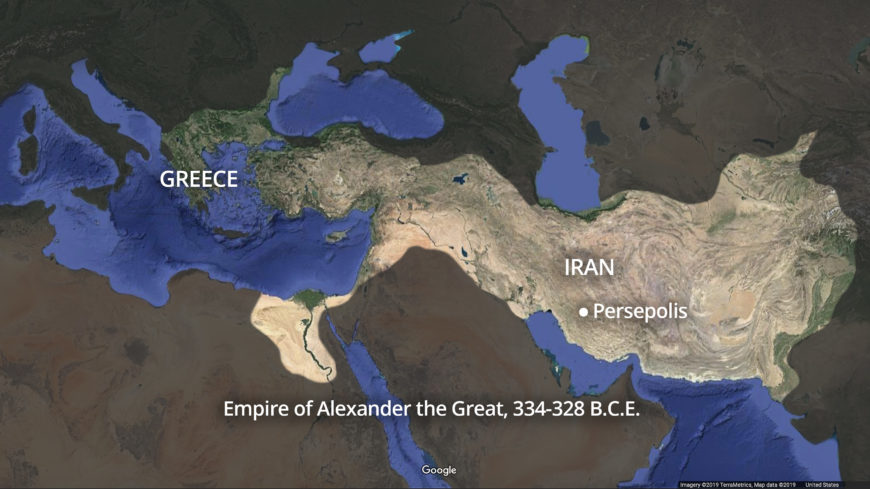Alexander Mosaic, c. 100 B.C.E., Roman copy of a lost Greek painting, House of the Faun, Pompeii, c. 315 B.C.E., Hellenistic Period (Archaeological Museum, Naples); speakers: Dr. Beth Harris and Dr. Steven Zucker
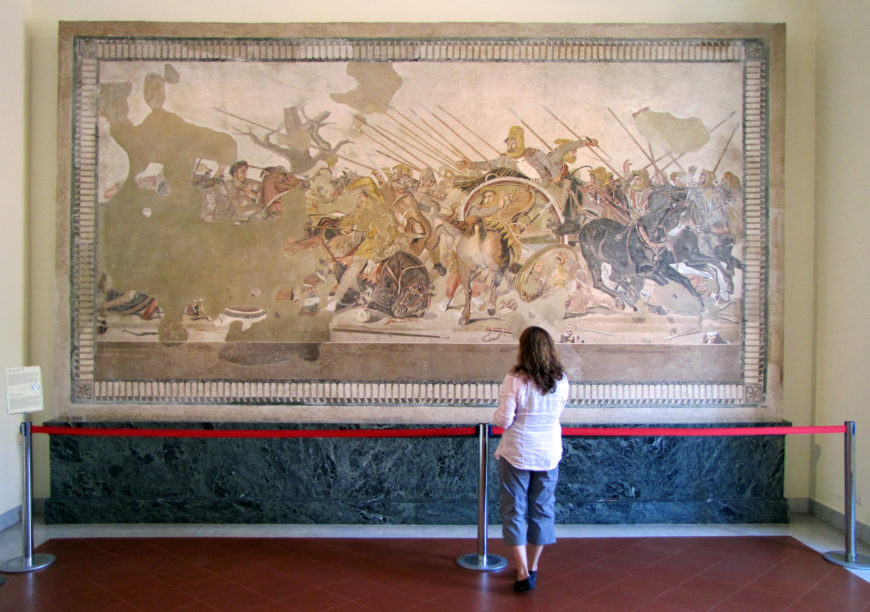
The Alexander Mosaic as seen on the wall of the Museo Archeologico Nazionale di Napoli, Alexander Mosaic, created in the 2nd century B.C.E., from the House of the Faun in Pompeii
A mighty general (Alexander the Great) charges on horseback across the field of battle. His spear makes contact with a soldier’s torso, who begins to recoil in pain and shock, on the verge of falling over the dead body of a horse strewn on the ground behind him. On the other side of the battlefield, a charioteer scrambles frantically to turn his horses around, trampling bodies beneath their hooves, in an attempt to get the opposing general (Darius) to safety.
These are just some of the evocative scenes depicted in the Alexander Mosaic.
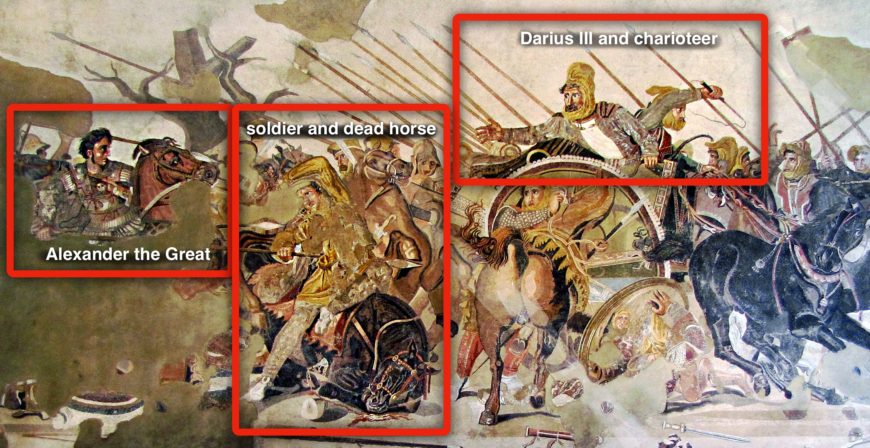
Annotated detail, Alexander Mosaic, created in the 2nd century B.C.E., from the House of the Faun in Pompeii, reconstructed in the National Archaeological Museum, Naples
This battle is usually identified as the Battle of Issus, a great fight that occurred on November 5, 333 B.C.E. in what is now modern-day Turkey [1]. It took place between the (Hellenic League) forces of the Macedonian-Greek Alexander the Great and the (Achaemenid Persian) forces of Darius III—a struggle which would ultimately result in a victory for Alexander.
The mosaic in context
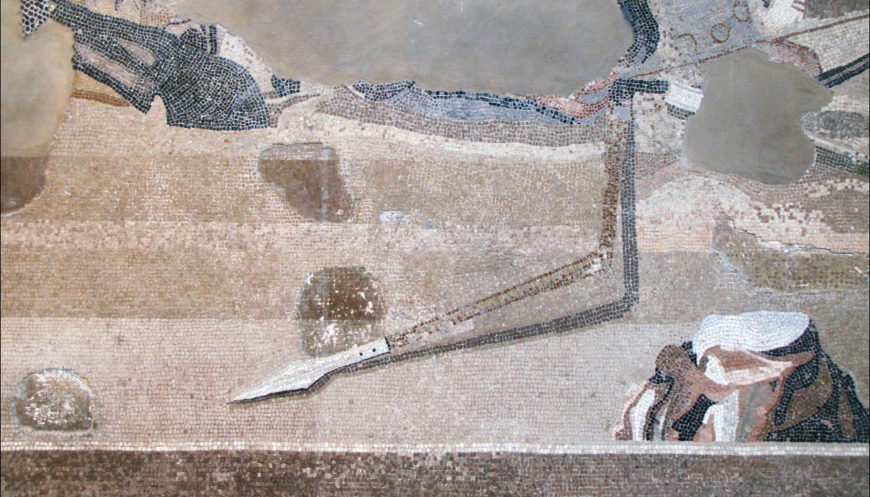
Detail of tesserae, Alexander Mosaic, created in the 2nd century B.C.E., from the House of the Faun in Pompeii, reconstructed in the National Archaeological Museum, Naples
The Alexander Mosaic (8 ft 11 in × 16 ft 10 in) is made up of approximately 1.5 million tesserae, which are small, cubed pieces of glass or stones cut into shape. The mostly earth-colored stones are remarkably tiny and used to emphasize the details of the scene. They are laid down in a style known as opus vermiculatum, a technique which is identified as “worm-like” due to the curved lines of tesserae placed to emphasize features and figures within the work.
The mosaic, which was created in the 2nd century B.C.E., once covered the entire floor of a room located between the two peristyle gardens of the large and grand House of the Faun in Pompeii. Today, a modern replica can be seen in Pompeii, while the original has been transferred to the Museo Archeologico Nazionale di Napoli (Naples National Archaeological Museum). The original mosaic survives in such good condition because it was protected by layers of ash from the 79 C.E. volcanic eruption of Mount Vesuvius until its rediscovery in 1831.
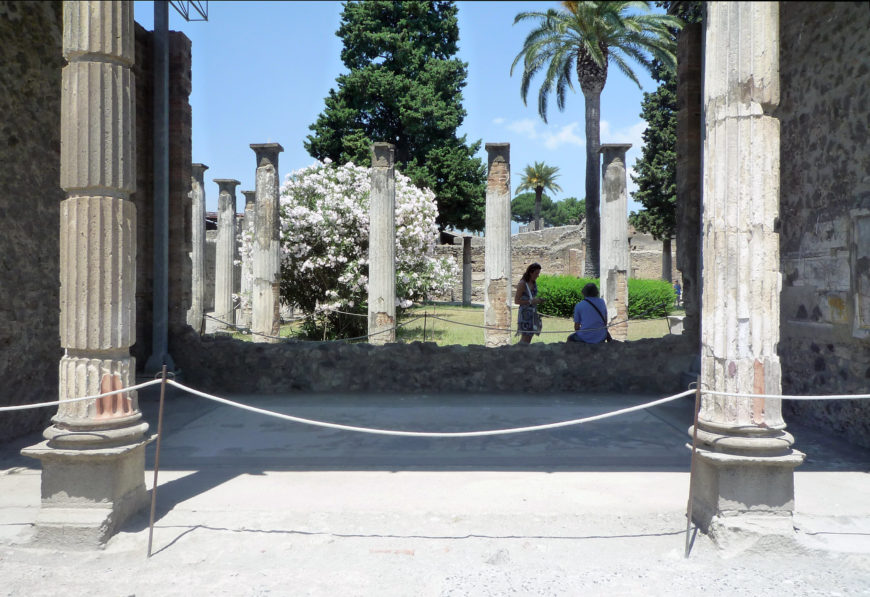
Modern Reconstruction of the Alexander Mosaic, in situ at the House of the Faun in Pompeii (closer view here)
The field of battle
Though parts of the mosaic have been damaged in the more than two millennia since its creation, much of the dramatic scene is still visible today.
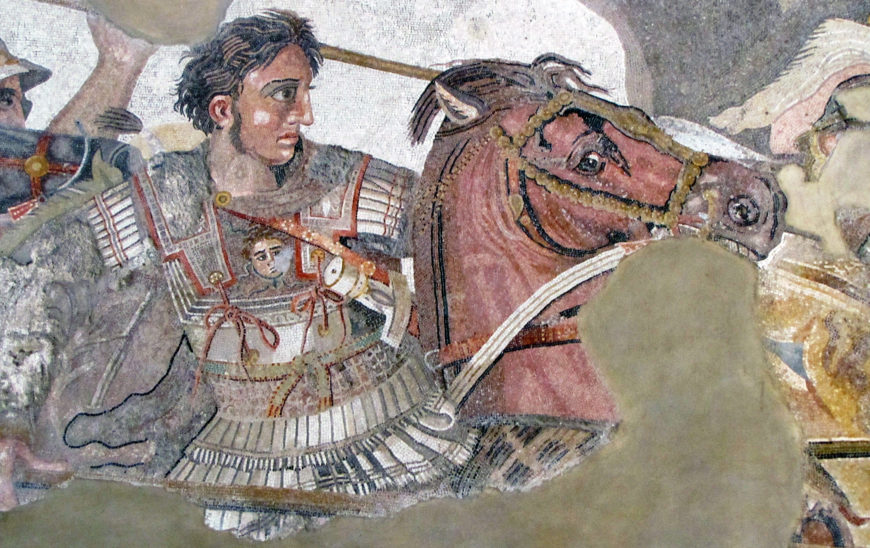
Detail of Alexander the Great, Alexander Mosaic, created in the 2nd century B.C.E., from the House of the Faun in Pompeii, reconstructed in the National Archaeological Museum, Naples
Near the left side of the mosaic, Alexander charges forward on his horse (named Bucephalus), fully armored, but wearing no helmet. His gaze is intense and confident, and his hair flies out behind him from the force of his forward momentum. His army follows closely as they advance towards the spear-carrying soldiers of the Persian army. In his right hand he holds a sarissa, a type of long spear invented by his father (Philip II, the former King of Macedon), which became an essential tool of Alexander and his forces as they conquered his empire.
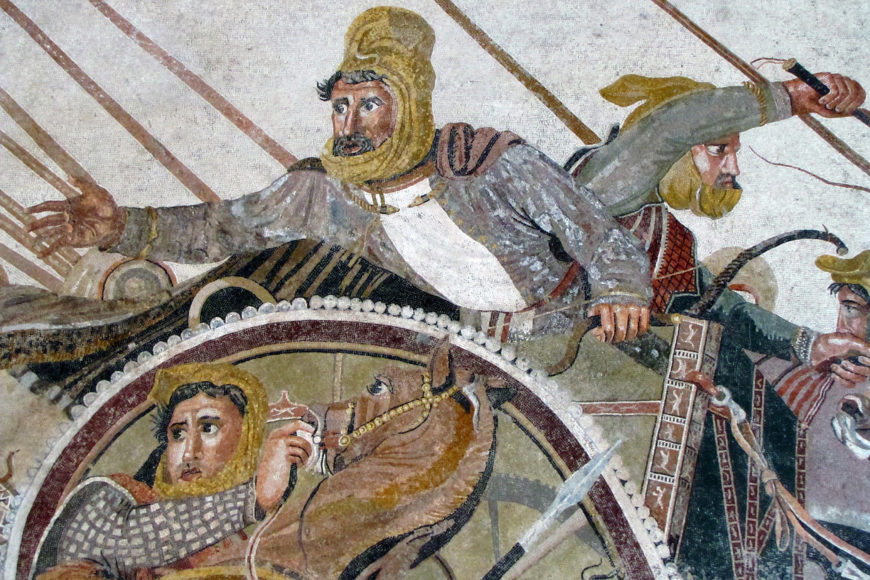
Detail of Darius III, Alexander Mosaic, created in the 2nd century B.C.E., from the House of the Faun in Pompeii, reconstructed in the National Archaeological Museum, Naples
Alexander rides towards the Persian army, led by Darius III, located on the right side of the mosaic, standing atop his chariot.
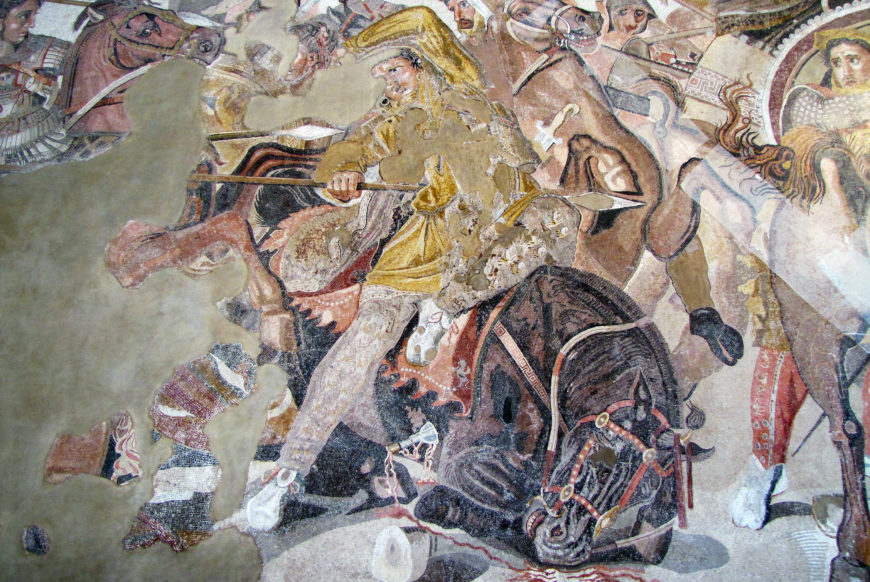
Detail of an impaled soldier (often identified as one of Darius’ kinsmen), jumping in front of the spear and taking the blow meant for his king (Darius III), Alexander Mosaic, created in the 2nd century B.C.E., from the House of the Faun in Pompeii, reconstructed in the National Archaeological Museum, Naples
Before Alexander’s spear can make contact with Darius, a man, often identified as one of Darius’ kinsmen, jumps in front of the spear and takes the blow meant for his king. Behind Darius and facing in the opposite direction, the charioteer frantically tries to wheel the chariot around. Holding the reins tightly with his left hand, he raises a whip in his right hand to spur the horses to move faster through the crowd of soldiers across a battlefield that is strewn with blood, bodies, and abandoned weapons. The shock of this moment is reflected in Darius’ face. The artist succeeds in capturing the devastation and fear in Darius’ facial expression. He desperately reaches out in vain towards his dying kinsman, looking towards Alexander.
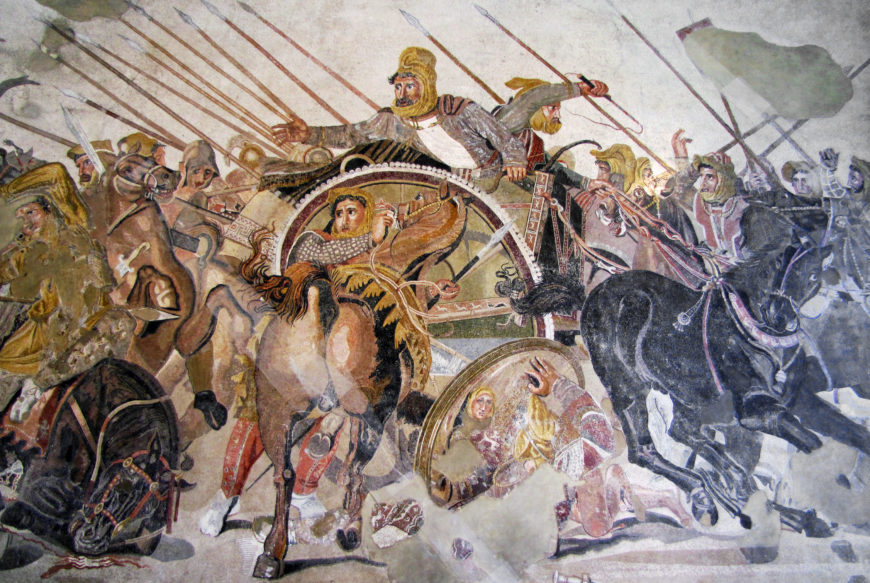
Detail of Persian soldiers and Darius III in his chariot, Alexander Mosaic, created in the 2nd century B.C.E., from the House of the Faun in Pompeii, reconstructed in the National Archaeological Museum, Naples
The artist captures the frenzied movements and fearful eyes of the horses as they trample soldiers and Darius flees from the battle, eyes still fixed on Alexander.
Although Alexander wins this battle, Darius is the tallest figure in the mosaic, elevated by the chariot on which he stands and puts his grief on prominent display.
An artist’s skill
This mosaic is remarkable not just for representing this significant battle, but also for the level of detail and naturalism it displays. All of the figures from humans to horses are rendered with a sense of three-dimensional, naturalistic modeling. By the late classical period and into the Hellenistic period, representations of figures had shifted from classical idealism to humanistic depictions which emphasized realistic anatomy and emotion, as is evident here.
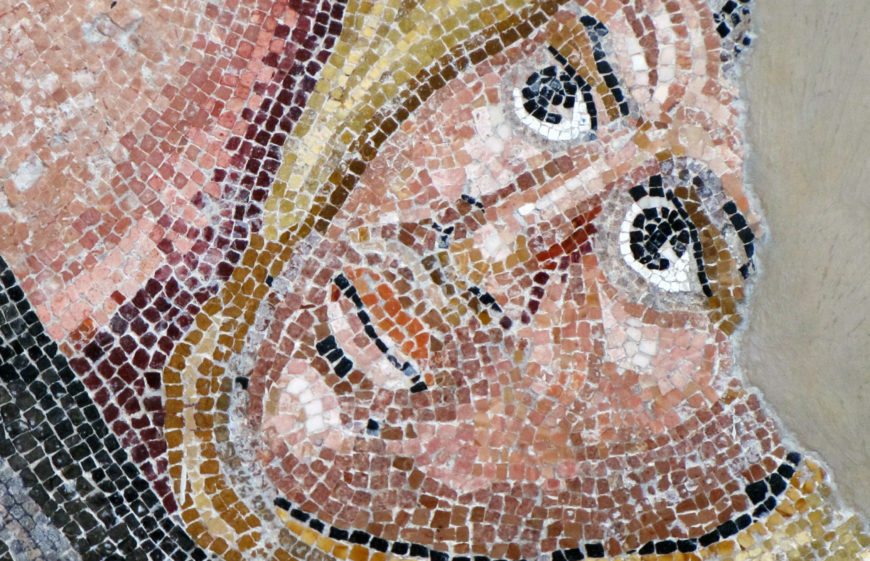
Detail of soldier’s face with tesserae arranged to create light and shadow, Alexander Mosaic, created in the 2nd century B.C.E., from the House of the Faun in Pompeii, reconstructed in the National Archaeological Museum, Naples
The tesserae are also used effectively to create light, shadow, and reflection. For example, there is a figure who has been knocked to the ground by the fleeing chariot. In a moment of introspection, he stares at the reflection of his own face on a shield, perhaps just before the moment of his own death. The incredible skill of the artist renders dynamic moments like these in realistic ways.
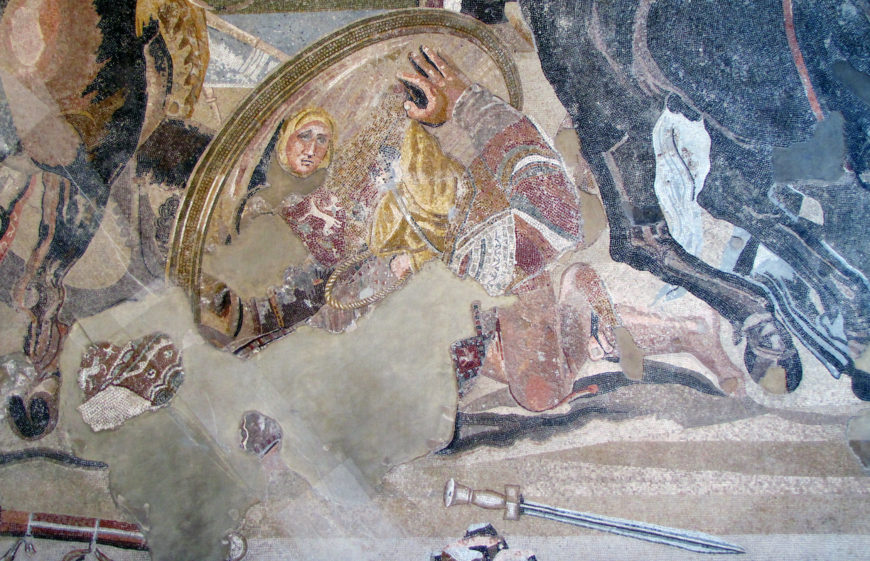
Detail of fallen soldier’s face reflected in a shield, Alexander Mosaic, created in the 2nd century B.C.E., from the House of the Faun in Pompeii, reconstructed in the National Archaeological Museum, Naples
Though the landscape in which the battle takes place is a barren one with little suggestion of setting, the figures display three-dimensionality, an excellent example of how well the ancient Greeks understood the body and how it moved through space. This is evident, for example, in the foreshortening of figures like the horse near the center right of the mosaic. The horse’s flank also displays tonal gradation, where colors transition gradually from a lighter tone to a darker one.
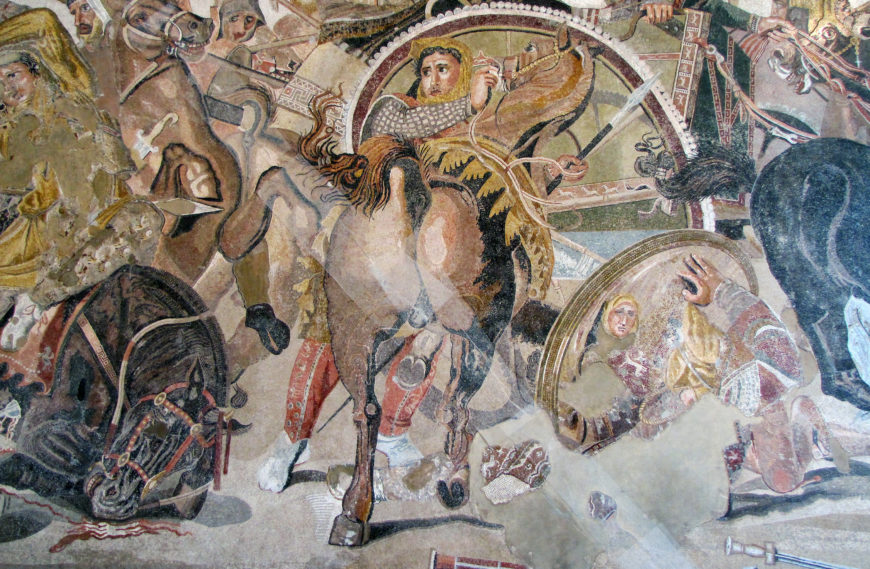
Detail of foreshortened horse, Alexander Mosaic, created in the 2nd century B.C.E., from the House of the Faun in Pompeii, reconstructed in the National Archaeological Museum, Naples
Greek origins
Compared to the crowded and frenetic battle scene below, the top half of the composition is mostly empty, broken only by spears and a bare, gnarled tree.
So why is the top half of this mosaic so vacant? The answer likely lies in the mosaic’s origins.
This stunningly detailed floor mosaic is usually believed to be a copy of an earlier Greek wall painting. Ancient Greek paintings were a highly popular and respected art form, but unfortunately, examples today are nearly nonexistent. [2] Unlike Roman wall paintings which were painted directly on the wall and therefore fixed and immovable, Greek wall paintings were usually painted on panels which were inserted into walls. These panel paintings could be removed from the wall and replaced as desired. While this was very practical at the time, they were constructed from more impermanent materials which frequently do not survive.
As a painting, the scene would have been displayed on a vertical wall. Given the size, much of the top half of the composition would have been well above the heads of the viewers and therefore not as easily viewed or necessary to fill with objects and figures. We can get a sense of what this looks like today from the mosaic’s wall-mounted position in the Naples National Archaeological Museum.
Though the Greek paintings themselves no longer exist, their influence can be seen in Etruscan and Roman paintings and mosaics, such as this one. Alexander the Great employed many artists during his reign as did his father before him. As Alexander’s empire spread, so too did the artistic styles that began to develop during his lifetime. Even after his death, artists during the Hellenistic period copied or were influenced by these works.
This was a mosaic meant to impress. The House of the Faun is the single largest residence in Pompeii and one of the most opulently decorated. By choosing to showcase this scene in his house, which is a copy of such a famous work, it would suggest to guests that the owner was highly educated in Greek culture and speaks to the Roman fascination with Greek art.
A battle won
Although he was outnumbered by Darius’ forces, Alexander defeated him at the Battle of Issus. The battle was considered a turning point leading to the decline of Achaemenid power, and ultimately, paved the way for Alexander’s conquest, which culminated in him burning the Persian capital Persepolis in 330 B.C.E. Even though he died at the young age of 32, Alexander succeeded in creating one of the largest empires of the ancient world.
Although none of the original paintings of Alexander and Darius survive, the mosaic allows us to see what it may have looked like, capturing a moment in time during a frenetic and emotional battle. Even after more than 2,000 years, the mosaic continues to fascinate all those who look upon it.
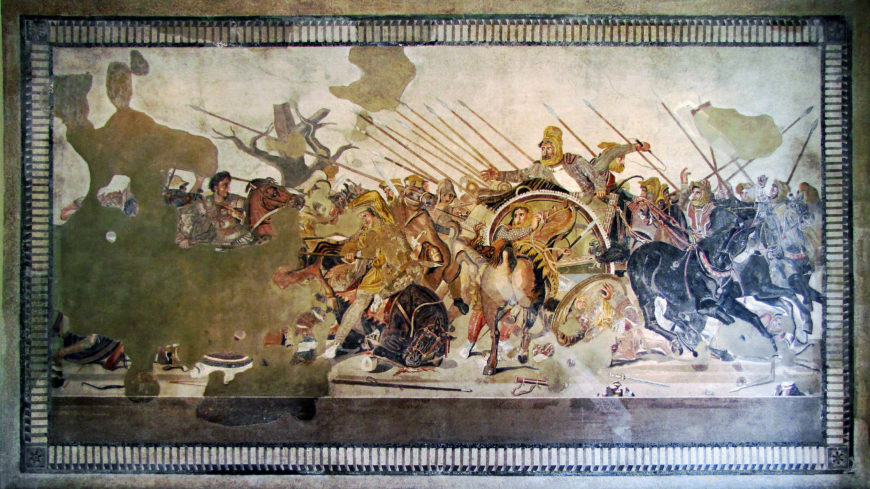
Alexander Mosaic, created in the 2nd century B.C.E., from the House of the Faun in Pompeii, reconstructed in the National Archaeological Museum, Naples
Notes:
[1] The other possible candidate is the Battle of Gaugamela which took place in 331 B.C.E. and is the second time that Alexander and Darius directly fought each other.
[2] A few mid – late 4th century B.C.E. Macedonian paintings survive in the tombs of Vergina, Greece.
Additional resources
The Alexander Mosaic at the Museo Archeologico Nazionale di Napoli
Watch a Smarthistory video about the Alexander Mosaic
Learn More about Mosaic Materials
Ancient and Byzantine Mosaic Materials, Art, Institute of Chicago
Ada Cohen, Art in the era of Alexander the Great: paradigms of manhood and their cultural traditions (Cambridge: New York: Cambridge University Press, 2010).
Ada Cohen, The Alexander Mosaic: Stories of Victory and Defeat (Cambridge University Press, 1997).
Christine Mitchell Havelock, Hellenistic Art: The Art of the Classical World from the Death of Alexander the Great to the Battle of Actium (New York Graphic Society LTD, 1981), pp. 252-253.
Paul Zanker (translated by Deborah Lucas Schneider), Pompeii: Public and Private Life (Cambridge, Mass.: Harvard University Press, 1998), pp. 39-42.
Smarthistory images for teaching and learning:
[flickr_tags user_id=”82032880@N00″ tags=”Alexander Moasic,”]

